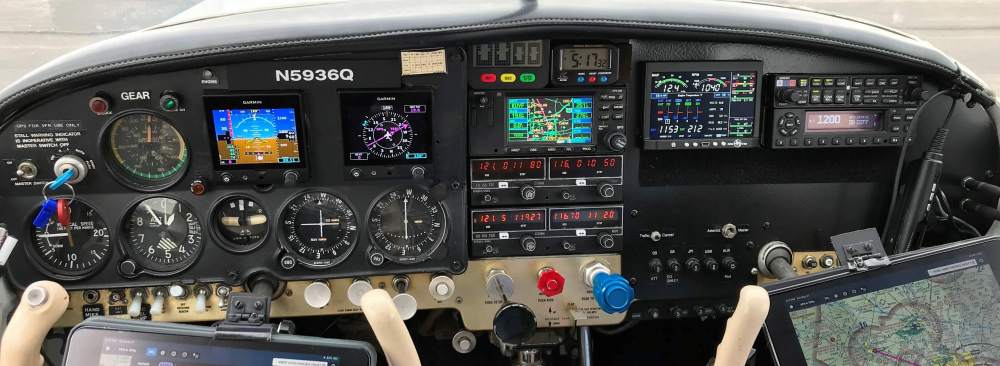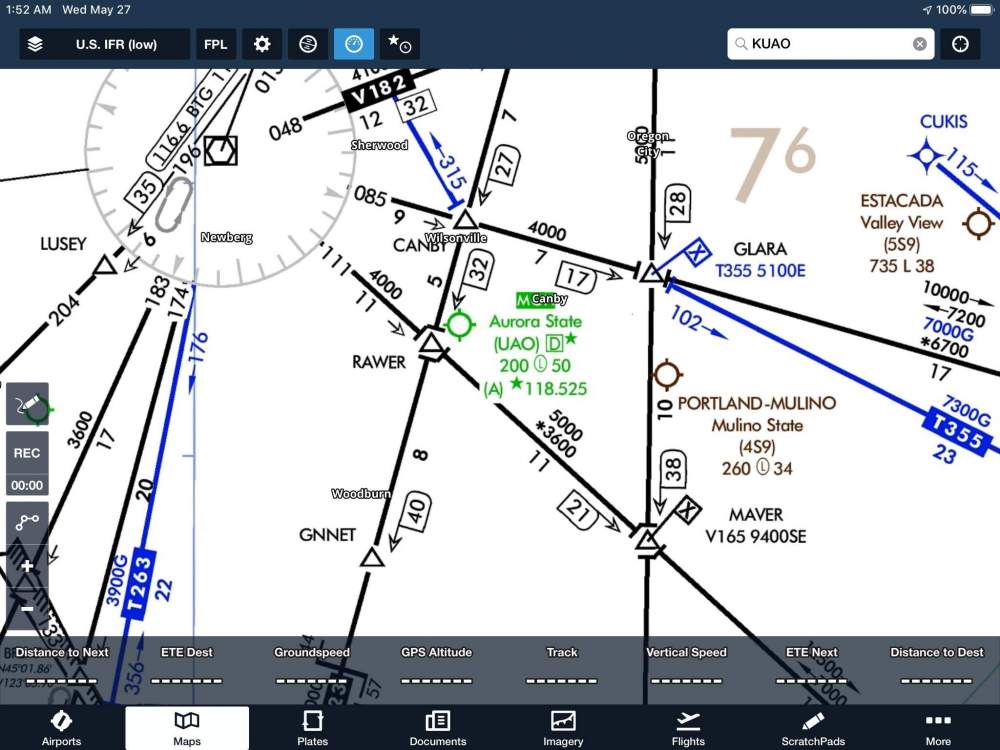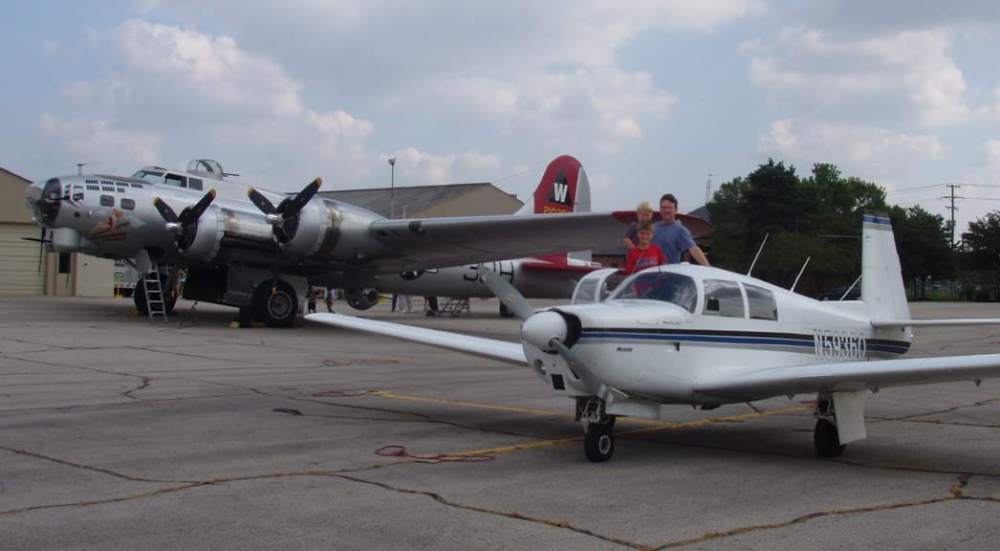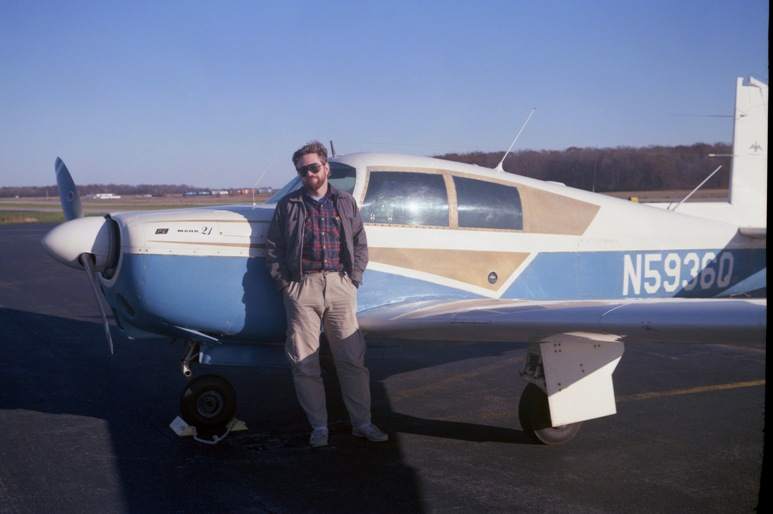-
Posts
213 -
Joined
-
Last visited
-
Days Won
1
Content Type
Profiles
Forums
Blogs
Gallery
Downloads
Events
Store
Everything posted by Bob E
-
OMG! GORGEOUS M20C!! Congratulations Thanks for posting pix.
-
Hank -- "I don't care." Pretty much sums up your attitude. Wow. Why bother to post at all? Just to vent your anger at Apple, FBOs, and ArtVandelay?
-
PIX!! Please Is it airworthy? Since yours is about 2600 TT, about 600 SMOH, and the avionics work, it sounds great so far. The M20C is a fantastic aircraft! BTW my '65 M20C sat on a ramp in Texas for 5 years before I bought it. Don't be in a rush to buy avionics. Plan carefully. Decide whether you want a VFR or an IFR aircraft. Carusoam is right that everyone seems to have a different avionics preference, so check out the forum here on Mooneyspace regarding panels and avionics, look at the ads in Trade-a-Plane, and do your homework.
-

Extending the service life of the Garmin GNS430W / GPS400W
Bob E replied to Bob E's topic in Avionics/Panel Discussion
Since my M20C is a forever plane (I've owned it for 34 years and now my son, age 23, now has the keys to it too), resale value wasn't a factor in choosing Garmin. When I upgraded my panel the criteria I used were basically as follows: Simple, functional layout. All buttons and controls easy to access and use with minimal distractions. (It took a long time to find the right clock and digital timer.) Simple and clear navigation visuals with no clutter. I decided not to go with a large panel-mounted glass display, so I use the GPS screen for navigation only, and use the iPad to display charts, traffic, weather, and plates. Avoiding single points of failure. Engine monitor functions, radios, GPS navigation, and legacy navigation are all separate systems. Also, each G5 has its own separate altitude readout and its own attitude indicator and battery backup. "Bulletproof" quality. That's the reason I kept the KX-155 radios, which despite being at least 25 years old, have LED upgrades and will likely be functional for another 10 years or more. It's also the reason I chose Garmin. I know Aspen had some issues a few years ago. (Plus I never did much like the Aspen vertical display in the middle of a panel, but that's subjective.) Compatibility. Some non-Garmin units are compatible, but I never saw much of an advantage to using them. I do use ForeFlight rather than Garmin Pilot. Aesthetics. I experimented with Photoshop to see what different panel layouts looked like. That helped a lot. -

Extending the service life of the Garmin GNS430W / GPS400W
Bob E replied to Bob E's topic in Avionics/Panel Discussion
Ragsf15e, I think you're right -- I'll ask the shop so I know for sure, but I presume the attitude info in my setup is coming from the 345, which also has an altitude encoder that ATC sees -- so those two items of info must be going from the 345 to the 400W via the canbus network connection. Each G5 also has a static connection and has its own attitude sensor -- but I presume they aren't exporting any data. Come to think of it, I can't even say for sure whether my ADS/B info is originating with the 345 or the 400W. My iPads don't have GPS; all continuous information flow regarding attitude, altitude, position, traffic, and weather is from the FS210 to them. Anyway, in my OP I was just sharing my happiness at not having to hassle with twisting and pushing anymore. But now you've got me curious.... -

Extending the service life of the Garmin GNS430W / GPS400W
Bob E replied to Bob E's topic in Avionics/Panel Discussion
Kortopates: I switched off the BT on the 345 since I don't need it and I didn't want the iPads to accidentally log into the wrong BT connection. Good idea to consider the 345 to be a backup, although my GPS antenna is now connected to the 400W, which shoots the info via Connext over to the 345, rather than vice versa (which is the way it was before the Flight Stream), so if the 400W goes down the BT on the 345 may not have anything to send.. My main backup, if the Garmin GPS does down, is a little Dual GPS 150 (non WAAS obviously) that's plugged into the power port. Regarding over-reliance on the iPad, I don't think it's much of an issue. A far greater issue is the distraction and time it takes to change an approach by twisting and selecting and pushing while trying to fly the airplane. The iPad is barely distracting at all, and it leaves the GPS screen operational while entering the approach. The iPad is required for me to be legal anyway since I haven't used paper charts for years. (Have a couple for emergencies.) -

Extending the service life of the Garmin GNS430W / GPS400W
Bob E replied to Bob E's topic in Avionics/Panel Discussion
Hammdo, that's exactly the setup process I used for the Flight Stream 210. Does that video involve the Flight Stream, or are there other Bluetooth interfaces that are TSO'd? (If so, apparently I didn't check around enough!) -
(FYI: I have zero affiliation with Garmin. I'm just a Mooney owner based in Ohio. This isn't an ad, just my opinion!) My M20C has a pretty decent IFR panel (photo below): a Garmin GPS400W that drives two G5's (one as PFD and the other as HSI), and is also connected into a GTX-345 transponder that -- since it has bluetooth -- sends position data plus ADS/B traffic and weather to my two iPad minis running ForeFlight. (The GPS400W is the same as a GNS430W without the nav/coms. I have two KX-155's because I like to keep radios separate from the GPS.) The units are all connected together via Garmin's "Connext" network setup. It all works great, and the setup makes it easy to fly pretty much whatever approach I want. But here's the thing: Even though they are fully compatible with G5's and other newer units thanks to the Connext networking standard, even though there's a huge installed base of these units, and even though Garmin will support them for many years to come, the 400W, like the 430W, is a legacy unit. The biggest drawback (to me) is that every single fix, every single approach, has to be entered one letter at a time -- twist, select, enter, twist, select, enter..... it takes FOREVER! Entering a single flight plan can take 15 minutes, and if you have to change anything like an approach in mid-flight, it's distracting. I was thinking about maybe upgrading to a GPS 175, but that's pricey, and installation isn't rack-compatible with the 430W series, so that would be expensive too. And even with the GPS 175, you still have to twist knobs, scroll through menus, and press select to enter waypoints! In ForeFlight, I can enter flight plans at home or in the aircraft by simply typing in the identifiers of the waypoints I want, and they appear instantly on the map. I can change waypoints or approaches instantly. If only I could send the ForeFlight data to the 400W. So I looked around and found the answer to my prayers! (Even though I'm not even religious. ) Garmin has a little box called the Flight Stream 210 that enables precisely that. It gives the 400W / 430W a bluetooth connection and the capability of synching with ForeFlight. Installed price was well under 2 AMUs. I couldn't resist. It's the best of all possible worlds -- its bluetooth connection still sends all the position data and ADS/B traffic and weather data to the iPads (I switched off the GTX-345 bluetooth). But now I can enter a flight plan or waypoints into ForeFlight, press the "send to panel" icon, and a message pops up on the 400W "accept flight plan data?" I press "enter" on the 400W, and the flight plan is instantly loaded into the 400W. It automatically synchs with the other iPad too! If I want to add an approach, I can do that in seconds on the fly - pun intended - and transfer it to the 400W instantly. No more twisting knobs! If I want, I can enter changes on the 400W and they will synch back to the iPads too, but thus far the only thing I've found it makes sense to do in that direction is deleting waypoints to go direct. To me, this is a far better setup than the 175 or even the big glass screens. I have the simple, clean screen of the 400W and the super-fast, easy functionality of ForeFlight. The Flight Stream 210 just breathed years of new life into my legacy Garmin WAAS GPS. The one missing item (the big blank space in the photo) is for a GFC-500 autopilot if they ever certify it for the M20C! (Garmin is obviously giving me time to save up for it.)
-
ATC doesn't give advisories in the Hudson SVFR corridor, and doesn't even monitor the SFVR corridor frequency 123.05. The frequency is for pilots to self-announce their position near the reporting points so that other pilots are informed. You don't have to get any kind of clearance from ATC to fly the corridor. (To be clear, I'm talking about the VFR corridor below 1300 feet.)
- 23 replies
-
- new york center
- skyline route
-
(and 1 more)
Tagged with:
-
If you want to fly low, in the Hudson SVFR corridor "exclusion," you don't have to talk to any controllers at all. You do have to take the FAA's online course about the special rules that apply: https://www.faasafety.gov/gslac/ALC/course_content.aspx?pf=1&preview=true&cID=79 Following the rules is easy. Note that the VFR corridor has entry and exit points and reporting points along the way.
- 23 replies
-
- 3
-

-
- new york center
- skyline route
-
(and 1 more)
Tagged with:
-

I'm a little excited about this one:
Bob E replied to the_elkhartian's topic in Vintage Mooneys (pre-J models)
My two cents' worth: Don't assume the engine will make it to TBO. The overhaul was 25 years ago! If the aircraft wasn't flown for various stretches of time, there could be corrosion in the cylinders or the camshafts, etc. Scope the engine very thoroughly, or maybe plan on installing a zero-time engine as part of your purchase budget. Ditto for the prop and prop governor. I suppose you can get used to anything, but for an aircraft that someone devoted a lot of time and money to modding a while back, the panel is one huge mess. Haphazard placement of avionics and instruments; no organizational concept. Where's the redline RPM range for the prop control? It's not a Mooney gauge; does the current engine/prop configuration no longer have a restricted range or did nobody bother with that issue? Kinda wierd that a later-model panel was cut and overlaid onto the C -- you can see some of the original "C" around the throttle/prop controls and where the yokes meet the panel. -
Whenever radar coverage is available, I always request flight following. It doesn't matter if I'm not heading anywhere in particular; approach or the tower appreciates knowing that I'm on frequency and what I'm up to. (Thanks to ADS-B they already know who I am.) There's a good chance the tower was trying to contact you before your initial call. Surprising that the controller would waste precious seconds by asking your position - which would be blinking red on his screen -- rather than responding to your call with "Mooney triple niner whisky, immediate 90 degree left turn, do it NOW." Flight following is the best bargain in aviation safety -- it's free! Use it. Now, regarding the other guy, KUAO does have two IFR routes passing almost directly overhead (see below); the lowest of the MEAs is 4000. If he was on an IFR flight plan he was either talking to ATC or was in a nordo situation, but in either case to be at that altitude he was busting minimums by at least 500 feet. Even if he had declared an emergency ATC would have advised him of your position unless he had a total engine and electrical power failure. Something that was striking to me about your post were a number of phrases you used: "I didn't bother with . . ." "Again, I didn't bother with . . . " "I wasn't paying close attention . . . " "zoomed in too close. . . " Hmm. There are your take-home lessons! "ATC would have a tough time calling out traffic if we were constantly changing directions...." (huh??? No they don't.)
-

Flight Instructing in the Era of Covid-19
Bob E replied to donkaye, MCFI's topic in General Mooney Talk
Here's one of the more useful articles I've seen regarding risk assessment. It's based on science but it's practical and understandable. The factors it discusses are not specifically tailored to the flight instruction context but I think they're applicable. https://www.erinbromage.com/post/the-risks-know-them-avoid-them -

Flight Instructing in the Era of Covid-19
Bob E replied to donkaye, MCFI's topic in General Mooney Talk
That's right. It also contains a really good explanation of the legal basis for them. -

Flight Instructing in the Era of Covid-19
Bob E replied to donkaye, MCFI's topic in General Mooney Talk
Just for fun, here's a Supreme Court decision from 1905 regarding mandatory vaccination. It's still good law. See the highlighted parts. Jacobson v Commonwealth of Massachusetts.pdf -
Wow!!! My kids and I have done just a tiny bit of work on the restoration of Champaign Lady (Urbana Ohio), but nothing even close to what you've been able to do. How cool!
-
-
Oh, just realized I calculated the serial numbers based on MinneMooney's photo, not yours. Oh well. Anyway feel free to get in touch and we can discuss maintenance etc.
-
Nice!!! Amazing pristine original paint job. I wish you many enjoyable hours of safe flying. My '65 M20C is only 35 serial numbers away from yours. Here's what it looked like in 1986 when I bought it -- little did I imagine that I would own it for the next 34 years and counting! -- and what it looks like now. Take care of it and it will last forever. If you ever want to discuss the little quirks and preventive maintanance things to pay attention to, just give me a call. 614- (I spread the numbers out to prevent the spammer bots from picking it up) 446- (cell number) 2422. -Bob Ellis
-
Pstone - I might actually still have this. I will check and get back to you. If I still have it you're welcome to it (no charge) if you can put it to good use. Sorry for the delay; I don't check Mooneyspace very often. (I know, I know....)
-
Sorry, I don't log on often enough! I sold the gauge cluster and MP/FP gauge a couple of months ago. I have a few other instruments - artificial horizon, suction indicator, EGT, tach. Unadvertised: I also have some plastic instrument panel cover pieces (1 pilot side, 2 passenger side), a whole bunch of AirTex fabric and vinyl rolls for seats (including approval documentation), about 10 headsets (all passive, no ANR) in good operating condition.
-
Very nice IFR bird - good combination of instrumentation, well-laid-out. (I assume the G5 is tied into the 430W.) May you enjoy many years of safe flying!
-
Thanks much, EricJ - much appreciated! The whole bulb debate may seem a bit absurd, but it's actually a fascinating dive into the arcane world of specs and standards that lurks behind the Part 91 stuff that us mere owner-pilots try to comply with. I'm an attorney and I'm used to in-depth research, but the amount of historical and current data / information you guys on this forum come up with is truly impressive.
-
EricJ and Cliffy, I'm not an engineer but I'd sure like to hear your responses to my questions above -- the ones about Whelan claiming TSO under C30b, a standard that no longer applies, and the three questions I asked right after that regarding TSO C30c, why incandescent position light bulbs aren't marked "TSO," and why I can't just replace a 7512-12 bulb with a 7512-12 bulb. I'm interested in this thread, but I can't believe aircraft owners need to have an engineering degree just to replace a light bulb. I'm perfectly happy to rely on my IA as well as the article in the October 2019 AOPA Pilot magazine. Maybe the real question is: "How many MooneySpace members does it take to change a light bulb?"
-

After Fire: A follow-up (we were lucky).
Bob E replied to Bob E's topic in Vintage Mooneys (pre-J models)
Skates - Yep, that works for me.- 8 replies
-
- fire
- overpriming
-
(and 1 more)
Tagged with:








